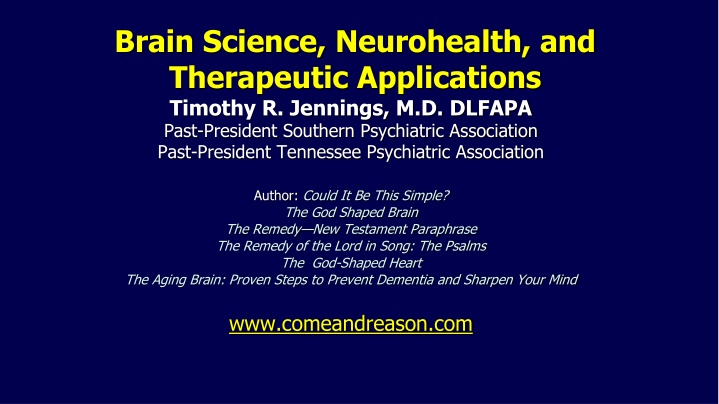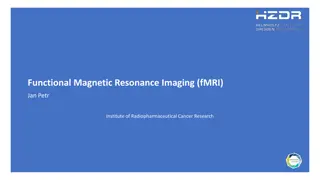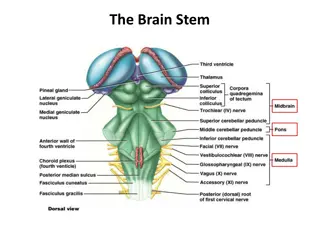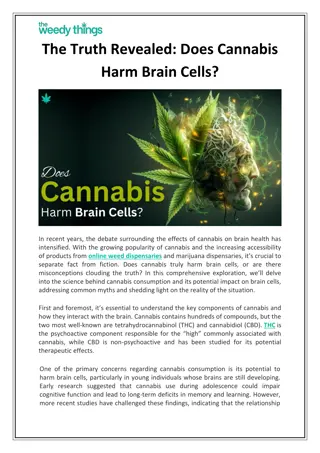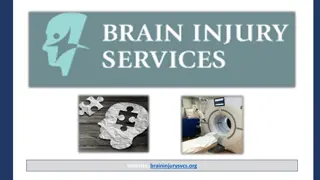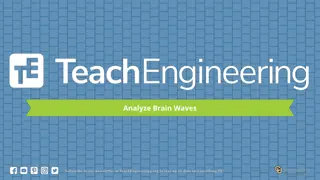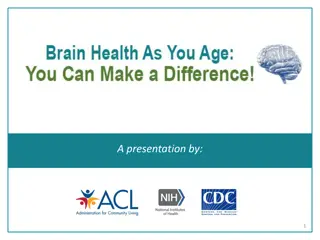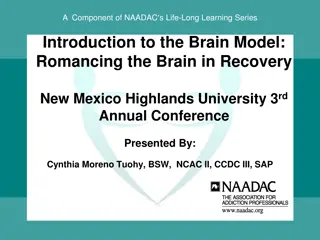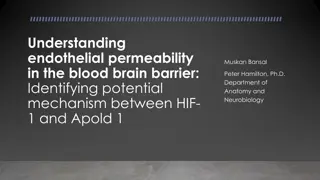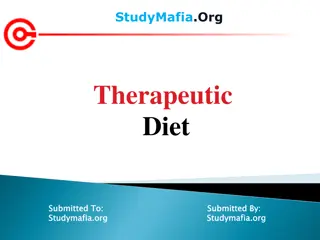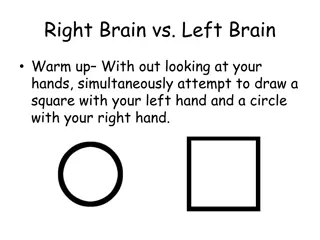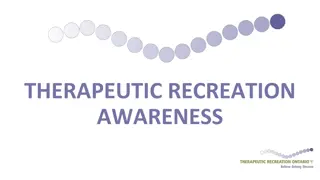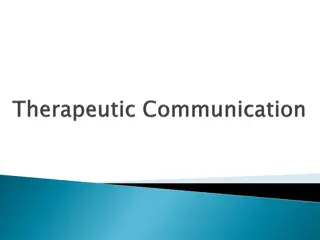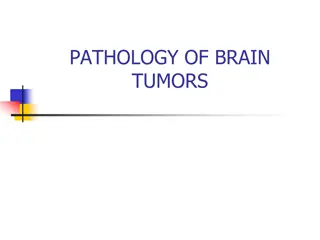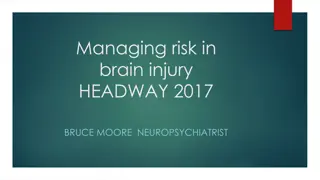Brain Science, Neurohealth, and Therapeutic Applications
Delve into the intricate world of brain science, neurohealth, and therapeutic applications with Timothy R. Jennings, M.D. Explore the impact of environmental influences, transgenerational epigenetic effects, and design laws on brain development. Discover interventions to enhance healthy brain function and the connection between belief and overall health. Gain insights into the cultural influences on mood and anxiety, and learn how to align beliefs with the laws of health for optimal well-being.
Download Presentation

Please find below an Image/Link to download the presentation.
The content on the website is provided AS IS for your information and personal use only. It may not be sold, licensed, or shared on other websites without obtaining consent from the author.If you encounter any issues during the download, it is possible that the publisher has removed the file from their server.
You are allowed to download the files provided on this website for personal or commercial use, subject to the condition that they are used lawfully. All files are the property of their respective owners.
The content on the website is provided AS IS for your information and personal use only. It may not be sold, licensed, or shared on other websites without obtaining consent from the author.
E N D
Presentation Transcript
Brain Science, Neurohealth, and Therapeutic Applications Timothy R. Jennings, M.D. DLFAPA Past-President Southern Psychiatric Association Past-President Tennessee Psychiatric Association Author: Could It Be This Simple? The God Shaped Brain The Remedy New Testament Paraphrase The Remedy of the Lord in Song: The Psalms The God-Shaped Heart The Aging Brain: Proven Steps to Prevent Dementia and Sharpen Your Mind www.comeandreason.com
Overview I. Brain Science, Development, & Epigenetics II. Neurohealth and Design Law III. Clinical and Therapeutic Applications IV. Case Applications
Disclosure for all Lectures I have no financial or commercial relationships with industry to disclose
Objectives 1. 2. Discuss environmental influences on brain development Recognize the significance of transgenerational epigenetic influences to human DNA and brain function Identify testable design parameters (laws of health) which life and health are built to operate upon and how deviations contribute to disease Identify specific interventions that promote healthy brain function Identify the relationship between belief and physical and mental health. Examine the scientific evidence documenting how a change in belief can alter brain function resulting in a change in health. Discuss the cultural impact on mood and anxiety Formulate a methodology for separating healthy from unhealthy beliefs. Formulate interventions that restore persons to harmony with the laws of health (God s design for life). 3. 4. 5. 6. 7. 8. 9.
Part I: Brain Science, Development, & Epigenetics Timothy R. Jennings, M.D. DLFAPA Medical Direct, Honey Lake Clinic Past-President Southern Psychiatric Association Past-President Tennessee Psychiatric Association Author: Could It Be This Simple? The God Shaped Brain The Remedy New Testament Paraphrase The Remedy of the Lord in Song: The Psalms The God-Shaped Heart The Aging Brain: Proven Steps to Prevent Dementia and Sharpen Your Mind www.comeandreason.com Slides at: comeandreason.com/AACC
Objectives 1. 2. Discuss environmental influences on brain development Recognize the significance of transgenerational epigenetic influences to human DNA and brain function Identify testable design parameters (laws of health) which life and health are built to operate upon and how deviations contribute to disease Identify specific interventions that promote healthy brain function Identify the relationship between belief and physical and mental health. Examine the scientific evidence documenting how a change in belief can alter brain function resulting in a change in health. Discuss the cultural impact on mood and anxiety Formulate a methodology for separating healthy from unhealthy beliefs. Formulate interventions that restore persons to harmony with the laws of health (God s design for life). 3. 4. 5. 6. 7. 8. 9.
Overview I. The Brain II.Parental/Environmental Influences III.Media Influences IV.Spiritual Influence
About the Brain 100 billion nerve cells Over 1 trillion supporting cells Each brain cell with up to 10,000 connections to other cells 40,000,000,000,000,000 Forty Quadrillion 1000 seconds: 1 million seconds 1 billion seconds 1 trillion seconds 1 quadrillion seconds 40 quadrillion seconds 16 minutes ago 11.5 days ago 32 years ago 31,688 years ago 24 million BC 1 billion BC
Microtubules: Tubulin 10 million microtubules per neuron Billions of tubulin molecules per neuron Each tubulin molecule composed of 445 amino acids
About the Brain 100 billion nerve cells Over 1 trillion supporting cells Each brain cell with up to 10,000 connections to other cells 40,000,000,000,000,000 Forty Quadrillion It is soft, like a banana in a hard case skull Weighs 3 pounds, 1-2% of body weight Uses 20% of the body s energy
Normal Brain Development The human brain is so complex that over 50% of the human genome codes for the brain1 More than twice as many neurons are produced than are eventually used1 During fetal development 50,000 neurons are produced per second1 Scheibel, A., Embryologic Development of the Human Brain, 1997: http://education.jhu.edu/PD/newhorizons/Neurosciences/articles/Embryological%20Development%20of%20the%20Human%20Brain/
Normal Brain Development From Birth to age 8 massive remodeling, with millions of neurons lost A second wave of neurogenesis, heavily concentrated in the PFC peaks in girls at 11 and boys at 12 followed by more remodeling and neuronal loss White matter maturation progresses from back to front culminating around age 25 When shown faces and asked to identify emotions, young teens activated their amygdala and limbic system, whereas in older teens activated the PFC. Giedd JN, Blumenthal J, Jeffries NO, et al. Brain development during childhood and adolescence: a longitudinal MRI study. Nature Neuroscience, 1999; 2(10): 861-3. Rapoport JL, Giedd JN, Blumenthal J, et al. Progressive cortical change during adolescence in childhood-onset schizophrenia. A longitudinal magnetic resonance imaging study. Archives of General Psychiatry, 1999; 56(7): 649-54. Baird AA, Gruber SA, Fein DA, et al. Functional magnetic resonance imaging of facial affect recognition in children and adolescents.Journal of the American Academy of Child and Adolescent Psychiatry, 1999; 38(2): 195-9.
Sleep Needs Newborns (0 3 months) 14 17 hours Infants (4 11 months) 12 15 hours Toddlers (1 2 years) 11 14 hours Preschoolers (3 5 years) 10 13 hours School-age (6 13 years) 9 11 hours Teenagers (14 17 years) 8 10 hours Young adults (18 25 years) 7 9 hours Adults (> 25 years) 7 8 hours
Section II Parental/Environmental Influences
Parental Influences Hereditary Environmental Behavioral/social
Epigenetics Conrad Waddington 1957 All cells have the same DNA yet different gene products Epi means above Genetics means DNA Epigenetics means above the DNA Transgenerational Gestational Environmental 18
Non Coding RNA (ncRNA) Ignored by biologists for years Splice genetic material1 Modify gene expression (epigenetics)2 Suppress entire chromosomes (Barr body)3 Elongate telomeres (telomerase) DNA defense (silence transposons)4 1. Kishore S, Stamm S (2006). "The snoRNA HBII-52 regulates alternative splicing of the serotonin receptor 2C". Science 311 (5758): 230 231. 2. Hirota K, Miyoshi T, Kugou K, Hoffman CS, Shibata T, Ohta K (2008). "Stepwise chromatin remodelling by a cascade of transcription initiation of non-coding RNAs".Nature 456 (7218): 130 4 3. 10.1101/gad.1811209Genes & Dev. 2009. 23:1831-1842 4. Yang, N., & Kazazian, H. H. L1 retrotransposition is suppressed by endogenously encoded small interfering RNAs in human cultured cells. Nature Structural and Molecular Biology 13, 763 771 (2006)
Fruit Flies Geldanamycin Outgrowths eyes 13 generations No DNA sequence change Gen 2-13 not exposed to drug1 1. Wong, Cell Research (2006)16: 742-749
Round Worms Fed with a particular type of bacteria exhibit loss of a green fluorescent protein and a small dumpy appearance that lasts 40 generations. No DNA sequence change Subsequent generations were not fed the bacteria Jablonka, E., and Raz, G. (2009). Q Rev Biol 84, 131-176.
Transgenerational Effects of Food Supply Grandfathers who had short food supply conferred greater mortality risks to grandsons Grandmothers conferred greater mortality risk to granddaughters X & Y transgenerational influences Eur J Hum Genet. 2006 Feb;14(2):159-66. http://www.ncbi.nlm.nih.gov/pubmed/16391557
Transgenerational Effects of Smoking Men who smoke before age 11 Increased obesity in sons, but not daughters Y Chromosome epigenetic changes Eur J Hum Genet. 2006 Feb;14(2):159-66. http://www.ncbi.nlm.nih.gov/pubmed/16391557
Smell of Fear F0 mice conditioned to fear odor (acetophenone) which activates known receptor (Olfr151) Generations F1&F2 had hypomethylation of gene Olfr151, with increased neural pathway for this olfactory odor, and subsequent fear of this smell. Genetic Memory? Nature Neuroscience 17, 89 96 (2014)
Smoking While Pregnant Smaller babies1 Increased SIDS1 Learning and behavior problems1 Increased psychotic disorders later in life1 1. http://cerhr.niehs.nih.gov/common/smoking.html 2. http://bjp.rcpsych.org/cgi/content/abstract/195/4/294
Air Quality While Pregnant Recent Study of 40 women & Children followed for 7-9 years Dose dependent relationship between polycyclic aromatic hydrocarbons exposure and reduced white matter in left hemisphere Slower information processing, increased ADHD and conduct problems :Petersen, et al., JAMA Psychiatry, March 25, 2015 online
Alcohol While Pregnant Increased psychosis Alcohol tastes better Mental retardation Multiple organ defects Fetal alcohol syndrome 1 drink/week or less shorter children/smaller heads Behavior problems Delinquency Emotional problems
Cannabis in Pregnancy CDC 16.2% of pregnant women between the ages of 18 and 44 are daily users; which is double the rate of use since 2009 70% of dispensaries in CO recommended marijuana to treat nausea particularly in the vulnerable first trimester; 36% of them also provided reassurance it was safe during pregnancy. Cannabis during pregnancy results in cannabinoid placental crossing and accumulation in the fetal brain as well as other organs, where it interferes with neurodevelopment and the endocannabinoid system. 1. 2. Stanciu, C. An Overview of Cannabis Use in Pregnancy, Psychiatric Times, June 25, 2020, https://www.psychiatrictimes.com/view/overview-cannabis-use-pregnancy Azofeifa A, Mattson ME, Schauer G, et al. National Estimates of Marijuana Use and Related Indicators - National Survey on Drug Use and Health, United States, 2002-2014. MMWR Surveill Summ. 2016;65:1- 28. www.cdc.gov/mmwr/volumes/65/ss/ss6511a1.htm. Accessed January 15, 2020. Young-Wolff KC, Tucker LY, Alexeeff S, et al. Trends in Self-reported and Biochemically Tested Marijuana Use Among Pregnant Females in California From 2009-2016. JAMA. 2017;318:2490-2491. Dickson B1, Mansfield C, Guiahi M, et al. Recommendations From Cannabis Dispensaries About First-Trimester Cannabis Use. Obstet Gynecol. 2018;131:1031-1038. Harkany T, Guzm n M, Galve-Roperh I, et al. The emerging functions of endocannabinoid signaling during CNS development. Trends Pharmacol Sci. 2007;28:83-92. Gunn JK, Rosales CB, Center KE, et al. Prenatal exposure to cannabis and maternal and child health outcomes: a systematic review and meta-analysis. BMJ Open. 2016;6:e009986. Huizink AC, Mulder EJ. Maternal smoking, drinking or cannabis use during pregnancy and neurobehavioral and cognitive functioning in human offspring. Neurosci Biobehav Rev. 2006;30:24-41. Fine JD, Moreau AL, Karcher NR, et al. Association of Prenatal Cannabis Exposure With Psychosis Proneness Among Children in the Adolescent Brain Cognitive Development (ABCD) Study. JAMA Psychiatry. 2019;76:762-764. Schneider M. Cannabis use in pregnancy and early life and its consequences: animal models. Eur Arch Psychiatry Clin Neurosci. 2009;259:383-93. The Health Effects of Cannabis and Cannabinoids. Washington, DC: National Academies Press; 2017. 3. 4. 5. 6. 7. 8. 9. 10.
Cannabis in Pregnancy Cannabinoids are secreted in breast milk for up to a week after use. Cannabis ingestion is associated with anemia in the mothers as well as low birth weights, greater risk of preterm and stillbirths, and increased need for neonatal intensive care unit admissions. Children born to mothers who used cannabis during pregnancy have higher rates of impulsivity, delinquency, learning and memory impairment as well as executive function deficits. There is also an increased association with proneness to psychosis during middle childhood. 1. 2. Stanciu, C. An Overview of Cannabis Use in Pregnancy, Psychiatric Times, June 25, 2020, https://www.psychiatrictimes.com/view/overview-cannabis-use-pregnancy Azofeifa A, Mattson ME, Schauer G, et al. National Estimates of Marijuana Use and Related Indicators - National Survey on Drug Use and Health, United States, 2002-2014. MMWR Surveill Summ. 2016;65:1- 28. www.cdc.gov/mmwr/volumes/65/ss/ss6511a1.htm. Accessed January 15, 2020. Young-Wolff KC, Tucker LY, Alexeeff S, et al. Trends in Self-reported and Biochemically Tested Marijuana Use Among Pregnant Females in California From 2009-2016. JAMA. 2017;318:2490-2491. Dickson B1, Mansfield C, Guiahi M, et al. Recommendations From Cannabis Dispensaries About First-Trimester Cannabis Use. Obstet Gynecol. 2018;131:1031-1038. Harkany T, Guzm n M, Galve-Roperh I, et al. The emerging functions of endocannabinoid signaling during CNS development. Trends Pharmacol Sci. 2007;28:83-92. Gunn JK, Rosales CB, Center KE, et al. Prenatal exposure to cannabis and maternal and child health outcomes: a systematic review and meta-analysis. BMJ Open. 2016;6:e009986. Huizink AC, Mulder EJ. Maternal smoking, drinking or cannabis use during pregnancy and neurobehavioral and cognitive functioning in human offspring. Neurosci Biobehav Rev. 2006;30:24-41. Fine JD, Moreau AL, Karcher NR, et al. Association of Prenatal Cannabis Exposure With Psychosis Proneness Among Children in the Adolescent Brain Cognitive Development (ABCD) Study. JAMA Psychiatry. 2019;76:762-764. Schneider M. Cannabis use in pregnancy and early life and its consequences: animal models. Eur Arch Psychiatry Clin Neurosci. 2009;259:383-93. The Health Effects of Cannabis and Cannabinoids. Washington, DC: National Academies Press; 2017. 3. 4. 5. 6. 7. 8. 9. 10.
Mothers Thinking While Pregnant Study of over 4000 mothers and their children Followed for over 18 years Mothers with negative, pessimistic, depressive thinking patterns when pregnant increased the risk of their child being depressed 18 years later. This association remained after accounting for maternal and offspring depression. The thought patterns of the mother accounted for 21% of the association between maternal and child depression. (Am Journal of Psychiatry 2013; 170:434-441).
What if Mother is Stressed While Pregnant? Mother s stress hormones cross the placenta Interferes with the stress response braking system This occurs through epigenetic modification Children are more stress prone, irritable, moody, and they pass this along to their children - unless new experience introduce new gene expression Medina, J. Psychiatric Times, April 2010, p. 16
Agouti Gene Expression What turns on the Agouti Gene?
What Turns Off the Agouti Gene? Methylation Mother s diet supplemented with folic acid and B12 Diet of mother during pregnancy changes the expression of genes in the child The methyl lock down passed down 3-4 generations. issue 2407 of New Scientist magazine, 09 August 2003, page 14
Jacob and his Sheep Jacob, however, took fresh-cut branches from poplar, almond and plane trees and made white stripes on them by peeling the bark and exposing the white inner wood of the branches. Then he placed the peeled branches in all the watering troughs, so that they would be directly in front of the flocks when they came to drink. When the flocks were in heat and came to drink, they mated in front of the branches. And they bore young that were streaked or speckled or spotted. (Gen 30:37-39 NIV84) Backon, Joshua, Jacob and the Spotted Sheep: The Role of Prenatal Nutrition on Epigenetics of Fur Color. Biology Publ ished 2008 https://www.semanticscholar.org/paper/Jacob-and-the-Spotted-Sheep%3A-The-Role-of-Prenatal-Backon/1 94ef71dd0af81f87cebdeda41ac64a85bc44a74
Gestational Effects of Food Supply Netherlands WWII Severe food shortage Children higher rates of diabetes, obesity, metabolic problems than did their siblings of same parents 5% less methyl caps on IGF2 gene Researchers believed this increased energy extraction from food Proceedings of the National Academy of Sciences, DOI: 10.1073/pnas.0806560105
Parental Environmental Factors
Animal Studies Pups of nurturing mothers (licking/grooming) compared to pups of mothers who didn t nurture Pups without attentive mothers had altered brain development such that they had over active amygdalas and social impairments When pups of neglect mothers were reared by nurturing mothers their amygdala development was the same as the pups of the nurturing mother http://www.ncbi.nlm.nih.gov/pubmed/15220929
Animal Studies First week of postnatal life rat pups were exposed to abusive mothering Altered BDNF in PFC, and these rats grew up to be poor mothers Their offspring were born with the altered BDNF and also had mothering problems. If taken at birth from the poor mother and raised by a nurturing mother, BDNF expression only partially altered Biological Psychiatry Volume 65, Issue 9, Pages 760 769, May 1, 2009
Child Abuse and Gene Expression in Brain Tissue 41 Canadian men (25 severe abuse, 16 controls) DNA examined from hippocampal neurons 362 different epigenetic changes 248 hypermethylated 114 hypomethylated Those most significantly affected where genes which regulated neuronal plasticity Arch Gen Psych, 2012; 69(7):722-731
Childhood Adversity Represents a Risk for Adulthood Disease 70 Number of Adverse Childhood Experiences 60 0 (n=502) 1 (n=253) % of Study Members With the Condition 2 (n=98) 50 40 30 20 10 0 Panel 1: Major Depression Panel 2: hsCRP >3 mg/L Panel 3: Clustering of Metabolic Risk Markers 32-year prospective study. Major depression (panel 1): z=4.94, P<.001. High-sensitivity C-reactive protein (hsCRP) level 3 mg/L (panel 2): z=3.24, P=.001. Clustering of metabolic risk markers (panel 3): z=4.58, P<.001. 1 age-related disease risks (panel 4): z=5.66, P<.001. Adapted from Danese A, et al. Arch Pediatr Adolesc Med. 2009;163(12):1135-1143. 45
Childhood Stress Decreases Reward Firing Stress between K to 3rdgrade was predictor of decreased reward firing from ventral tegmental area at age 26 This increases risk for mental health problems later in life, more depression, less normal reward, greater risk for substance problems. Jamie L Hanson et al. Cumulative Stress In Childhood is Associated with Blunted Reward-Related Brain Activity In Adulthood, Social Cognitive and Affective Neuroscience (2015). DOI: 10.1093/scan/nsv124
Adults who were abused as children Have higher rates of medical illnesses Have higher rates of mental illnesses Have higher suicide rates Have higher alcohol/drug problems
Mice Engineered for Memory Problems Enriched environment 2 weeks adolescence Improved memory Offspring improved memory despite genetic defect and no enriched environment Environment caused epigenetic changes which were passed to offspring Junko A. Arai, Shaomin Li, Dean M. Hartley, and Larry A. Feig Transgenerational Rescue of a Genetic Defect in Long-Term Potentiation and Memory Formation by Juvenile Enrichment J. Neurosci., Feb 2009; 29: 1496 - 1502 ; doi:10.1523/JNEUROSCI.5057- 08.2009
Mice with neuronal loss experienced improved memory after enriched environment due to epigenetic changes Histone acetylation improves memory, dendritic sprouting, synaptic connections 49 Nature 447, 178-182 (10 May 2007)
Protective Factors Family member confidant1 significantly reduced the risk of overall behavioral and emotional problems by age 18. Females at age 18 who had a family member confidant higher self-esteem and reduced risks of major mental disorders, suicidal thoughts, depression, drug disorders, and overall behavioral problems Males with advice-giving families had better school performance, lower school dropout rates, less depression, behavioral or emotional problems Family cohesion2 males and females had higher grades, greater likelihood in receiving school and community honors, and a reduced risk of numerous problems and some mental disorders. Family cohesion appeared to be especially important for young women in reducing risk of serious mental disorders. 1. Child and Adolescent Social Work Journal Oct 2002, Vol 19, Is 5, p 393-412 2. American Journal of Orthopsychiatry, Vol 59(1), Jan 1989, 59-71
